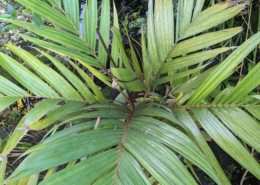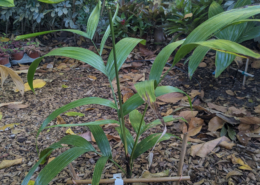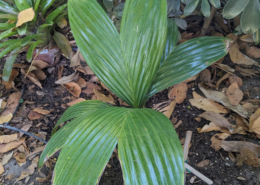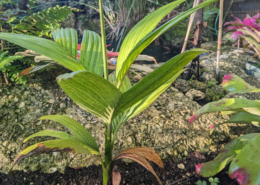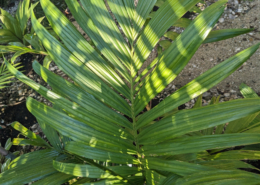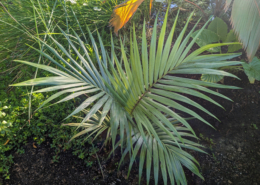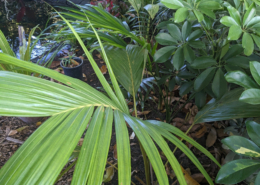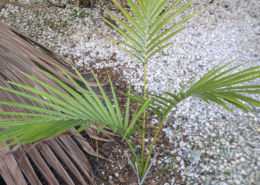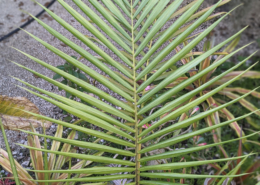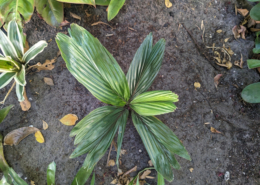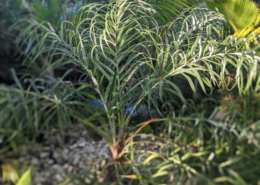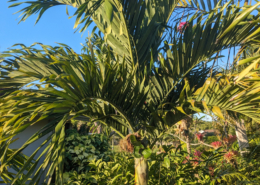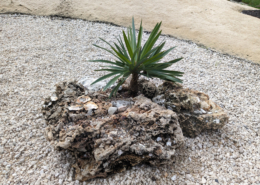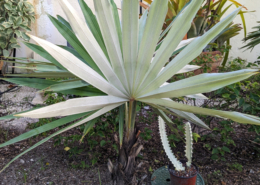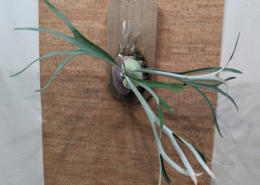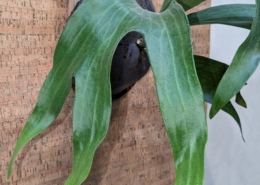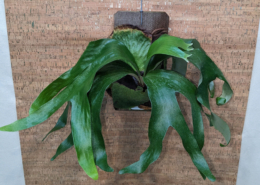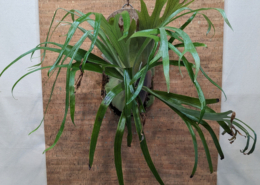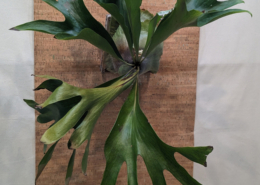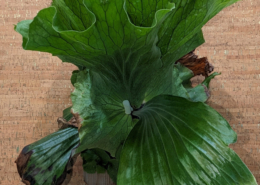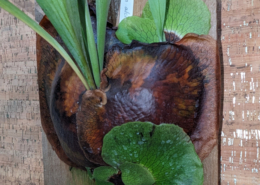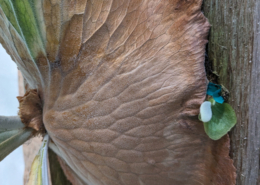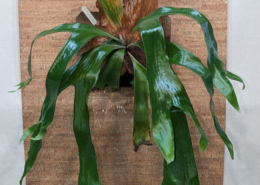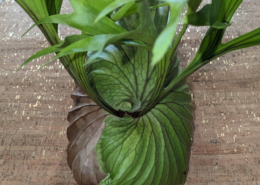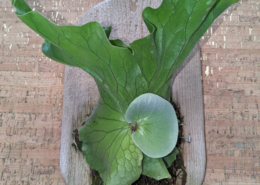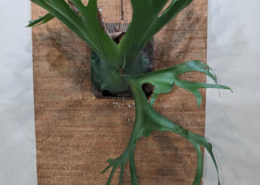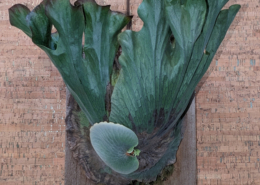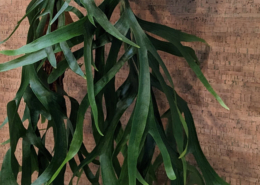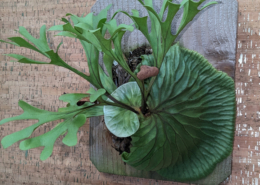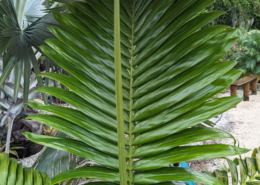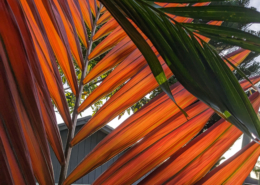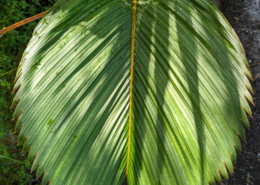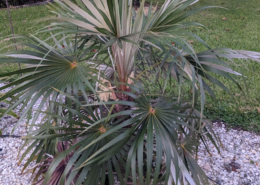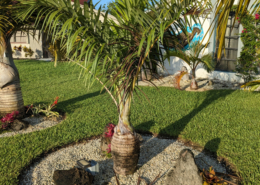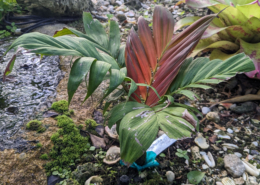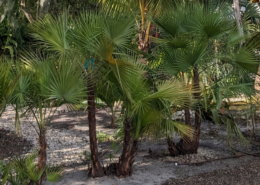Palms “Arecaceae”
at Hideaway Palmetum
The 100 Arecaceae Species at Hideaway Palmetum
| Acoelorrhaphe wrightii | (uh-SEAL-uh-rafe) (RIGHT-ee-eye) |
| Actinorhytis calapparia | (ahk-tin-oh-REE-tiss) (kah-lahp-pahr-EE-ah) |
| Adonidia merrillii | (ah-doh-nih-DEE-ah) (mehr-RILL-ee) |
| Aiphanes horrida | (ah-ee-FAHN-ehz) (HOHR-ree-dah) |
| Allagoptera arenaria | (ahl-lah-gohp-TEH-rah) (ahr-eh-nahr-EE-ah) |
| Allagoptera caudescens | (ahl-lah-gohp-TEH-rah) (kah-DEHS-sens) |
| Archontophoenix cunninghamiana | (ahr-kohn-toh-FEH-niks) (kuhn-ning-ham’-ee-ahn-ah) |
| Archontophoenix myolensis | (ahr-kohn-toh-FEH-niks) (migh-oh-LEN-sis) |
| Archontophoenix purpurea | (ahr-kohn-toh-FEH-niks) (puhr-puhr-EH-ah) |
| Archontophoenix tuckeri | (ahr-kohn-toh-FEH-niks) (tuhk-er’-ee) |
| Areca catechu | (ah-REHK-ah) (kah-TEH-koo) |
| Areca catechu “Dwarf” | (ah-REHK-ah) (kah-TEH-koo) |
| Areca guppyana | (ah-REHK-ah) (guhp-pih’-YAH-nah) |
| Areca oxycarpa | (ah-REHK-ah) (ahks-ee-KAHR-pah) |
| Areca tunku | (ah-REHK-ah) (TOON-koo) |
| Areca vestiaria | (ah-REHK-ah) (vehs-tee-ahr-EE-ah) |
| Areca vestiaria ‘Red form’ | (ah-REHK-ah) (vehs-tee-ahr-EE-ah) |
| Arenga hookeriana | (ah-REN-gah) (hook-ehr-ee-AHN-ah) |
| Astrocaryum mexicanum | (ahs-tro-kahr-EE-uhm) (meks-sih-KAHN-uhm) |
| Bentinckia condapanna | (ben-tink-EE-ah) (kohn-DAH-pahn-nah) |
| Bismarckia nobilis | (biz-mark’-ee-ah) (noh-BILL-ihs) |
| Burretiokentia hapala | (bur-ret-ee-oh-kent-EE-ah) (hah-PAH-lah) |
| Burretiokentia vieillardii | (bur-ret-ee-oh-kent-EE-ah) (vee-ehl-LAHR-dee) |
| Calyptrocalyx albertisianus | (kah-lip-troh-KAH-liks) (ahl-behr-tihs-ee-AHN-ûs) |
| Calyptrocalyx hollrungii | (kah-lip-troh-KAH-liks) (hohl-ROON-gee) |
| Calyptrocalyx leptostachys | (kah-lip-troh-KAH-liks) (lep-toh-STAHK-iss) |
| Calyptrocalyx pachystachys | (kah-lip-troh-KAH-liks) (pahk-ih-STAHK-iss) |
| Carpentaria acuminata | (kahr-pen-tahr-EE-ah) (ah-koo-mih-NAHT-ah) |
| Carpoxylon macrospermum | (kahr-PAHX-ih-lahn) (mak-roh-SPEHR-muhm) |
| Chamaedorea cataractarum | (kahm-eh-doh-REH-ah) (kaht-ah-rahk-TAHR-uhm) |
| Chamaedorea ernesti-augusti | (kahm-eh-doh-REH-ah) |
| Chamaedorea metallica | (kahm-eh-doh-REH-ah) (meh-TAHL-lih-kah) |
| Chamaedorea metallica “Split Leaf” | (kahm-eh-doh-REH-ah) (meh-TAHL-lih-kah) |
| Chamaedorea oblongata | (kahm-eh-doh-REH-ah) (ob-long-GAH-tah) |
| Chamaedorea seifrizii | (kahm-eh-doh-REH-ah) (see-FRIZ-ee) |
| Chambeyronia (Kentiopsis ) oliviformis | (kam-beh-ROH-nee-ah) (oh-lee-VIH-form-miss) |
| Chambeyronia (Kentiopsis ) pyriformis | (Kent-ee-OHP-sis) (py-rih-FOR-mis) |
| Chambeyronia macrocarpa “watermelon” | (kam-beh-ROH-nee-ah) (mak-roh-KAR-pah) |
| Chambeyronia macrocarpa hookeri | (kam-beh-ROH-nee-ah) (mak-roh-KAR-pah) (hook-EHR-ee) |
| Chrysalidocarpus (Dypsis) cabadae | (kriss-al-lid-oh-KAR-pus) (kah-BAHD-eh) |
| Chrysalidocarpus (Dypsis) lanceolata | (kriss-al-lid-oh-KAR-pus) (lahn-seh-oh-LAH-tah) |
| Chrysalidocarpus (Dypsis) leptocheilos | (kriss-al-lid-oh-KAR-pus) (lehp-toh-KAY-lohs) |
| Chrysalidocarpus (Dypsis) lutescens | (kriss-al-lid-oh-KAR-pus) (loo-TEHS-senz) |
| Chrysalidocarpus (Dypsis) pembana | (kriss-al-lid-oh-KAR-pus) (pehm-BAH-nah) |
| Coccothrinax inaguensis | (koh-koh-TRIH-naks) (ihn-ah-goo-EN-siss) |
| Coccothrinax argentata | (koh-koh-TRIH-naks) (ar-jehn-TAH-tah) |
| Coccothrinax barbadensis | (koh-koh-TRIH-naks) (bar-bah-DEN-sis) |
| Coccothrinax borhidiana | (koh-koh-TRIH-naks) (bor-hid-ee-AHN-ah) |
| Coccothrinax clarensis | (koh-koh-TRIH-naks) (clahr-EN-sis) |
| Coccothrinax crinita | (koh-koh-TRIH-naks) (krin-EE-tah) |
| Coccothrinax macroglossa | (koh-koh-TRIH-naks) (mak-roh-GLOHS-ah) |
| Coccothrinax miraguama | (koh-koh-TRIH-naks) (mehr-ah-goo-AHM-ah) |
| Coccothrinax miraguama subsp. roseocarpa | (koh-koh-TRIH-naks) (mehr-ah-goo-AHM-ah) |
| Coccothrinax montana | (koh-koh-TRIH-naks) (mohn-TAH-nah) |
| Cocos nucifera “Maypan” | (KOH-kohs) (noo-SIFF-ehr-ah) |
| Cocos nucifera “Gold Malaysian” | (KOH-kohs) (noo-SIFF-ehr-ah) |
| Corphia utan | (kohr-EE-fah) (OO-tahn) |
| Cyphosperma balansae | (sigh-foh-SPUHR-mah) (bah-LAHN-seh) |
| Cyrtostachys renda | (sihr-toh-STAHK-iss) (REHN-dah) |
| Dictyosperma album var. conjugatum | (dik’-tie-oh-SPURM-ah) (ALL-buhm) (kohn-joo-GAH-tuhm) |
| Dypsis rosea | (DIP-sis) (roh-ZEH-ah) |
| Dypsis Sp. “Maroantsetra” | (DIP-sis) |
| Elaeis guineensis | (eh-leh-iss) (gwee-neh-EN-sis) |
| Euterpe Sp. “Orange Crownshaft” | (yoo-TEHR-peh) |
| Gaussia attenuata | (GAWS-see-ah) (at-ten-oo-AH-tah) |
| Gaussia gomez-pompae | (GAWS-see-ah) (goh-mez)-(pom’-peh) |
| Gaussia princeps | (GAWS-sih-ah) (PREEN-sehps) |
| Hemithrinax ekmaniana | (heh-mee-TRIH-nahks) (ehk-MAHN-ee-ahn-ah) |
| Heterospathe elata | (heht-eh-roh-SPATH-eh) (eh-LAH-tah) |
| Hydriastele beguinii | (high-dree-Ah-STEL-eh) (beh-GWIN-ee) |
| Hyophorbe lagenicaulis | (hy-oh-FOR-beh) (lahg-en-ih-KAW-lis) |
| Hyophorbe verschaffeltii | (high-oh-FOR-beh) (ver-kahf-FELT-ee) |
| Itaya amicorum | (ih-TAH-yah) (ahm-ih-KOR-uhm) |
| Latania loddigesii | (lah-tah-NEE-ah) (loh-dih-JEEZ-ee) |
| Licuala grandis | (lik-oo-AH-lah) (GRAHN-dis) |
| Licuala spinosa | (lik-oo-AH-lah) (spih-NO-sah) |
| Neoveitchia storckii | (neh-oh-vih-KEE-ah) (stork’-ee) |
| Normanbya normanbyi | (nor-mahn’-bee-ah) (nor-mahn’-bee) |
| Phoenicophorium borsigianum | (fehn-ih-koh-fohr-EE-uhm) (bohr-see-jee-AHN-uhm) |
| Phoenix roebelenii | (FEH-niks) (roh-behl-LEHN-ee) |
| Pinanga coronata | (pih-NAHN-gah) (kohr-oh-NAH-tuh) |
| Pinanga sp. “Thai Mottled” | (pih-NAHN-gah) |
| Pinanga sp. “Yellow Crownshaft” | (pih-NAHN-gah) |
| Pritchardia pacifica | (pritch-AHR-dee-ah) (pah-sihf-EE-kah) |
| Pseudophoenix sargentii | (soo-doh-FEH-niks) (sahr-jent’-ee) |
| Ptychosperma caryotoides | (tee-koh-SPEHR-mah) (kahr-ee-oh-toh-EE-dehs) |
| Ptychosperma elegans “Paddle Leaf” | (tee-koh-SPEAR-mah) |
| Ptychosperma furcatum | (tee-koh-SPEHR-mah) (foor-KAH-tuhm) |
| Ptychosperma lauterbachii | (tee-koh-SPEHR-mah) (law-tehr-bahk’-ee) |
| Ptychosperma macarthurii | (tee-koh-SPEHR-mah) (mah-kahr-thur’-ee) |
| Ptychosperma salomonense | (tee-koh-SPEHR-mah) (sah-lah-mohn-EN-seh) |
| Ptychosperma schefferi | (tee-koh-SPEHR-mah) (shef’-fehr-ee) |
| Satakentia liukiuensis | (sah-tah-kehn-TEE-ah) (lee-oo-kee-oo-EHN-sis) |
| Schippia concolor | (skip-EE-ah) (kohn-kohl’-ohr) |
| Serenoa repens | (sehr-eh-NO-ah) (REH-penz) |
| Thrinax radiata | (TREE-nahks) (rah-dee-AH-tah) |
| Veitchia arecina | (veet-KEE-ah) (ah-reh-SEEN-ah) |
| Veitchia spiralis | (veet-KEE-ah) (speer-AHL-iss) |
| Veitchia vitiensis | (veet-KEE-ah) (vee-tee-EHN-siss) |
| Verschaffeltia splendida | (vehr-shaf-FELT-ee-ah) (splehn-DEE-dah) |
Plant Profile Pages (Under Construction)
Many of our plants are still young, the pictures in these profile pages are only of plants on location at Hideaway Palmetum.
The pictures are displayed as a means to track the plants progress over time not to give a full scope of their potential.
“Arecaceae” Bercht. & J.Presl
First published in Prir. Rostlin 266. 1820 (Jan-Apr 1820) ; nom. alt.: Palmae (1820)nom. cons.
The Kew Temperate Plant Families Identification Handbook.....
The Kew Temperate Plant Families Identification Handbook.
Gemma Bramley, Anna Trias-Blasi & Richard Wilford (2023).
Kew Publishing Royal Botanic Gardens, Kew
Description Author – William J. Baker
Recognition
Characters of similar families: Pandanaceae: linear leaves, flowers complex and not usually trimerous, fruit in heads. Cyclanthaceae: leaves not developing from an initially entire lamina. Asparagaceae (for example, arborescent Yucca, Cordyline, Dasylirion and Dracaena): linear leaves, not compound or plicate. Musaceae: non-woody pseudostems arising from corms, leaf entire. Cycadaceae: cone-bearing, compound leaves not developing from an initially entire lamina.
Morphology > General > Habit
Massive to minute woody monocotyledonous plants; trees, shrubs or climbers, sometimes spiny
Morphology > Stem
Stems clustered or solitary, erect, creeping or climbing, often massive, sometimes very short and/or subterranean, usually marked with leaf scars, sometimes dying after flowering, aerial stems usually unbranched
Morphology > Leaves > Leaf > lamina
Lamina almost always conspicuously folded
Morphology > Leaves
Leaf bases always tubular and sheathing (at least in the bud), often forming a conspicuous tubular crownshaft Leaves compound, less frequently entire; compound leaves derived by splitting of an initially entire lamina, pinnate, bipinnate or palmate
Morphology > Reproductive > morphology > Inflorescences
Inflorescences always lateral, often massive, spicate to paniculate, sometimes aggregated in a mass of inflorescences held above the leaves, resulting in the death of the stem
Morphology > Reproductive > morphology > Flowers
Flowers bisexual or unisexual (monoecious or dioecious); calyx or corolla usually comprising 3 free or fused sepals or petals, often inconspicuous, but some colourful and enlarged; ovary always superior, always no more than one ovule per carpel
Morphology > Reproductive > morphology > Fruits
Fruit a berry or drupe; minute to massive, usually 1–3-seeded, often brightly coloured, sometimes scaly or spiny.
Distribution
181 genera, c. 2,600 species. Primarily tropical and subtropical, especially in humid forests, but reaching temperate climates at their northern (southern France) and southern (Chatham Islands) limits. Also reaching high elevations in the tropics (up to 3,600 m in the Andes).
Note
Woody monocot trees, shrubs or climbers. Leaves usually compound, palmate, pinnate or rarely bipinnate, blade plicate, splitting along folds. Leaf bases tubular, usually sheathing. Inflorescences lateral. Fruit a berry or drupe.
183 Accepted Genera...
- Acanthophoenix H.Wendl.
- Acoelorraphe H.Wendl.
- Acrocomia Mart.
- Actinorhytis H.Wendl. & Drude
- Adonidia Becc.
- Aiphanes Willd.
- Allagoptera Nees
- Ammandra O.F.Cook
- Aphandra Barfod
- Archontophoenix H.Wendl. & Drude
- Areca L.
- Arenga Labill. ex DC.
- Asterogyne H.Wendl. ex Hook.f.
- Astrocaryum G.Mey.
- Attalea Kunth
- Bactris Jacq. ex Scop.
- Balaka Becc.
- Barcella (Trail) Drude
- Basselinia Vieill.
- Beccariophoenix Jum. & H.Perrier
- Bentinckia Berry ex Roxb.
- Bismarckia Hildebrandt & H.Wendl.
- Borassodendron Becc.
- Borassus L.
- Brahea Mart. ex Endl.
- Brassiophoenix Burret
- Burretiokentia Pic.Serm.
- Butia (Becc.) Becc.
- × Butyagrus Vorster
- Calamus L.
- Calyptrocalyx Blume
- Calyptrogyne H.Wendl.
- Calyptronoma Griseb.
- Carpentaria Becc.
- Carpoxylon H.Wendl. & Drude
- Caryota L.
- Ceroxylon Bonpl. ex DC.
- Chamaedorea Willd.
- Chamaerops L.
- Chambeyronia Vieill.
- Chelyocarpus Dammer
- Chrysalidocarpus H.Wendl.
- Chuniophoenix Burret
- Clinosperma Becc.
- Clinostigma H.Wendl.
- Coccothrinax Sarg.
- Cocos L.
- Colpothrinax Schaedtler
- Copernicia Mart. ex Endl.
- Corypha L.
- Cryosophila Blume
- Cyphokentia Brongn.
- Cyphophoenix H.Wendl. ex Hook.f.
- Cyphosperma H.Wendl. ex Hook.f.
- Cyrtostachys Blume
- Deckenia H.Wendl. ex Seem.
- Desmoncus Mart.
- Dictyocaryum H.Wendl.
- Dictyosperma H.Wendl. & Drude
- Dransfieldia W.J.Baker & Zona
- Drymophloeus Zipp.
- Dypsis Noronha ex Mart.
- Elaeis Jacq.
- Eleiodoxa (Becc.) Burret
- Eremospatha (G.Mann & H.Wendl.) Schaedtler
- Eugeissona Griff.
- Euterpe Mart.
- Gaussia H.Wendl.
- Geonoma Willd.
- Guihaia J.Dransf., S.K.Lee & F.N.Wei
- Hedyscepe H.Wendl. & Drude
- Hemithrinax Hook.f.
- Heterospathe Scheff.
- Howea Becc.
- Hydriastele H.Wendl. & Drude
- Hyophorbe Gaertn.
- Hyospathe Mart.
- Hyphaene Gaertn.
- Iguanura Blume
- Iriartea Ruiz & Pav.
- Iriartella H.Wendl.
- Itaya H.E.Moore
- Jailoloa Heatubun & W.J.Baker
- Johannesteijsmannia H.E.Moore
- Juania Drude
- Jubaea Kunth
- Jubaeopsis Becc.
- Kerriodoxa J.Dransf.
- Korthalsia Blume
- Laccospadix H.Wendl. & Drude
- Laccosperma (G.Mann & H.Wendl.) Drude
- Lanonia A.J.Hend. & C.D.Bacon
- Latania Comm. ex Juss.
- Lemurophoenix J.Dransf.
- Leopoldinia Mart.
- Lepidocaryum Mart.
- Lepidorrhachis (H.Wendl. & Drude) O.F.Cook
- Leucothrinax C.Lewis & Zona
- Licuala Wurmb
- Linospadix H.Wendl.
- Livistona R.Br.
- Lodoicea Comm. ex DC.
- Loxococcus H.Wendl. & Drude
- Manicaria Gaertn.
- Manjekia W.J.Baker & Heatubun
- Marojejya Humbert
- Masoala Jum.
- Mauritia L.f.
- Mauritiella Burret
- Maxburretia Furtado
- Medemia Württemb. ex H.Wendl.
- Metroxylon Rottb.
- Myrialepis Becc.
- Nannorrhops H.Wendl.
- Nenga H.Wendl. & Drude
- Neonicholsonia Dammer
- Neoveitchia Becc.
- Nephrosperma Balf.f.
- Normanbya F.Muell. ex Becc.
- Nypa Steck
- Oenocarpus Mart.
- Oncocalamus (G.Mann & H.Wendl.) H.Wendl.
- Oncosperma Blume
- Orania Zipp.
- Oraniopsis (Becc.) J.Dransf., A.K.Irvine & N.W.Uhl
- Parajubaea Burret
- Pelagodoxa Becc.
- Phoenicophorium H.Wendl.
- Phoenix L.
- Pholidocarpus Blume
- Pholidostachys H.Wendl. ex Benth. & Hook.f.
- Physokentia Becc.
- Phytelephas Ruiz & Pav.
- Pigafetta (Blume) Becc.
- Pinanga Blume
- Plectocomia Mart. ex Blume
- Plectocomiopsis Becc.
- Podococcus G.Mann & H.Wendl.
- Ponapea Becc.
- Prestoea Hook.f.
- Pritchardia Seem. & H.Wendl.
- Pseudophoenix H.Wendl. ex Sarg.
- Ptychococcus Becc.
- Ptychosperma Labill.
- Raphia P.Beauv.
- Ravenea H.Wendl. ex C.D.Bouché
- Reinhardtia Liebm.
- Rhapidophyllum H.Wendl. & Drude
- Rhapis L.f. ex Aiton
- Rhopaloblaste Scheff.
- Rhopalostylis H.Wendl. & Drude
- Roscheria H.Wendl. ex Balf.f.
- Roystonea O.F.Cook
- Sabal Adans.
- Sabinaria R.Bernal & Galeano
- Salacca Reinw.
- Saribus Blume
- Satakentia H.E.Moore
- Satranala J.Dransf. & Beentje
- Schippia Burret
- Sclerosperma G.Mann & H.Wendl.
- Serenoa Hook.f.
- Socratea H.Karst.
- Sommieria Becc.
- Syagrus Mart.
- Synechanthus H.Wendl.
- Tahina J.Dransf. & Rakotoarin.
- Tectiphiala H.E.Moore
- Thrinax L.f. ex Sw.
- Trachycarpus H.Wendl.
- Trithrinax Mart.
- Truongsonia A.J.Hend., N.S.Lý, W.J.Baker, S.Bellot, J.Dransf. & Eiserhar
- Veitchia H.Wendl.
- Verschaffeltia H.Wendl.
- Voanioala J.Dransf.
- Vonitra Becc.
- Wallaceodoxa Heatubun & W.J.Baker
- Wallichia Roxb.
- Washingtonia H.Wendl.
- Welfia H.Wendl.
- Wendlandiella Dammer
- Wettinia Poepp. ex Endl.
- Wodyetia A.K.Irvine
- Zombia L.H.Bailey
Palms are a monophyletic group of plants, meaning the group consists of a common ancestor and all its descendants.[14] Extensive taxonomic research on palms began with botanist H.E. Moore, who organized palms into 15 major groups based mostly on general morphological characteristics. The following classification, proposed by N.W. Uhl and J. Dransfield in 1987, is a revision of Moore’s classification that organizes palms into 6 subfamilies.[15] A few general traits of each subfamily are listed below.
- Subfamily Arecoideae are the largest subfamily with 14 tribes and containing over 100 genera. All tribes have pinnate or bipinnate leaves and flowers arranged in groups of three, with a central pistillate and two staminate flowers.
- Subfamily Calamoideae includes the climbing palms, such as rattans. The leaves are usually pinnate; derived characters (synapomorphies) include spines on various organs, organs specialized for climbing, an extension of the main stem of the leaf-bearing reflexed spines, and overlapping scales covering the fruit and ovary.
- Subfamily Ceroxyloideae has small to medium-sized flowers, spirally arranged, with a gynoecium of three joined carpels.
- Subfamily Coryphoideae are the second-largest subfamily with 8 tribes. Most palms in this subfamily have palmately lobed leaves and solitary flowers with three, or sometimes four carpels. The fruit normally develops from only one carpel.
- Subfamily Nypoideae contains only one species, Nypa fruticans,[16] which has large, pinnate leaves. The fruit is unusual in that it floats, and the stem is underground and dichotomously branched, also unusual in palms.





















